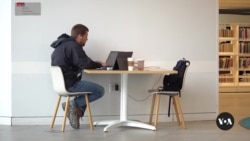Student Union
International Students Can Use US Investor Visa to Gain Green Card

A lesser-known immigration visa offers international students a path to U.S. colleges and universities — and a green card — but the price is affordable for only a few.
An EB-5, or Immigrant Investor Visa Program, does not restrict where or how much students work off-campus and allows them to stay in the country after graduation, both perks not available to F-1 student visa holders, according to EB-5 Daily, a website that aggregates news about the EB-5 program.
But in exchange for fewer restrictions, EB-5s have a daunting price tag — applicants must invest at least $500,000.
"There are a lot of wealthy international students who come to the U.S., and a lot of them are very motivated [to stay after graduation]," said Ishaan Khanna, a recent college graduate and EB-5 visa holder. "So, for them it makes sense."
A path to immigration
Khanna came to the U.S. from India on an F-1 student visa to study at Loyola Marymount University in Los Angeles. As graduation approached, he started looking for ways to stay and work in the U.S.
"If I wanted to further my career, being in the U.S., especially close to Silicon Valley, was a no brainer," said Khanna, who was looking for jobs in the tech sector. He started researching EB-5 visas during his senior year.
WATCH: Ishaan Khanna Talks About EB-5 Visa
The EB-5 visa program was created in 1990 to encourage foreign investment and create jobs for American workers, according to the Department of Homeland Security.
To receive the visa, a foreigner must invest at least $500,000 either directly in a business or in a regional center, which is a private company that pools such investments.
"An EB-5 regional center is an economic unit, public or private, in the United States that is involved with promoting economic growth," according to the U.S. Citizenship and Immigration Service (USCIS). "Regional centers are designated by USCIS for participation in the Immigrant Investor Program."
Each investment qualifies only if it creates or preserves at least 10 full-time jobs.
The vast majority of EB-5 investors — in 2016, 91.5 percent — have chosen to invest in regional centers. Successful applicants receive a two-year green card that becomes permanent if the investment meets the job-creation standard.
But there is so little oversight of the EB-5 industry that it is open to abuse, critics say.
"I could speak for hours about the corruption in this program," said Republican Senator Charles Grassley, one of the program's most vocal critics.
"They [the investors] put up the money and they don't know what the money is being used for," said Lsu Khanh Pham, an immigration attorney. "Legally, the money is supposed to go into the venture and create jobs."
But sometimes, he said, the money is used to pay back previous loans, or it sits in the bank as collateral.
Criticisms
Sometimes the money is embezzled, according to some court cases. Documentation shows 287 regional centers whose contract with the U.S. government has been terminated for either failing to submit required information to USCIS or for no longer serving the purpose of promoting economic growth. This month, there were 1,382 approved regional centers.
Last year, the family of Jared Kushner, President Donald Trump's son-in-law and a senior White House aide, was investigated for implying that their company's connection with the president could help their investors obtain green cards through the EB-5 program. The investigation is ongoing.
The appeal of a green card is undeniable. With a green card, a foreign student can "work, live, study, as freely as you want," Khanna said.
Students who hold a green card are much more attractive to employers, Khanna said.
"Let's' be honest, if you don't have a green card, it is really hard to get a job in America," he added.
"I interviewed for SpaceX and I remember making it through the first round of interviews," Khanna recalled about the company considered to be a leading innovator in space technology.
"And they looked at my application and they said, 'Oh you're not a citizen? You don't have a green card?' And I said 'no,' and they said, 'OK, this isn't going to work.'"
"Being able to work in the U.S. without requiring sponsorship is a big deal," he said.
USCIS can grant up to 10,000 EB-5 visas each year, but it is hard to get exact figures for how many students are in the U.S. on an EB-5.
"USCIS does not maintain these figures," a spokesperson for the agency said, speaking on background. A State Department representative, also speaking on background, directed VOA to its publicly available statistics, which do not include how many students hold an EB-5 visa.
"I would think several hundred students" get an EB-5 visa each year, said Stephen Yale-Loehr, a professor of immigration law at Cornell Law School and attorney for Miller Mayer LLP's immigration practice group. "But nobody knows for sure. It may only be a hundred."
However, Khanna, an EB-5 visa holder from India, said, "I do know a lot of people who do it, especially students."
Because regional centers profit from making investments on behalf of EB-5 applicants, they have a strong incentive to attract every investor they can, no matter how young.
On their websites, for example, the centers tout the virtues of EB-5 visas over traditional F-1 student visas.
The website of the U.S. Immigration Fund, one of the regional centers, included a post with the headline: "4 reasons why EB-5 visa program is the best for studying abroad in the U.S."
Where to invest
Although parents and families typically provide the money, students sometimes decide where to invest.
"That is probably the most daunting part of the EB-5 process for many investors," said Yale-Loehr, the immigration law professor.
"I compare it to a Rubik's Cube," he explained. "The immigration component has to line up with the [investment] component, which has to line up with the job creation element. ... Sometimes, if the students are majoring in business, they're very savvy."
But Khanna, who majored in applied-information systems management when he began the EB-5 process, said that determining where to invest was difficult. He spent months doing research and took advantage of resources on campus, "running up to finance professors to ask questions" during his senior year.
"I spoke to several investment issuers and I remember making this long spreadsheet, which listed all the different EB-5 projects and compared their pros and cons side by side," Khanna said.
He eventually invested in a Four Seasons hotel in Puerto Rico through a regional center named EB5 United, based in Santa Monica, California. He now works for EB5 United as the company's director of investor relations for India.
Although the USCIS has tried to protect against fraud, a 2015 Government Accountability Office report found that the agency needed to do even more to protect investors and discern how the program impacts the American economy.
Senator Grassley has frequently called for EB-5 reform and recently asked Congress to end regional centers altogether.
On Sept. 30, the program was extended until after the midterm elections but before the next Congress is seated in January. When the EB-5 program comes up for renewal on Dec. 7, President Trump and a lame-duck Congress will decide its fate. Until then, students looking for alternatives to an F-1 visa will be able to consider an EB-5, if they can afford it.
"If your family has resources, do it," Khanna advised.
And the investment Khanna made for his EB-5?
"It was pretty much my family's life savings which went into this," he said.
See all News Updates of the Day
- By VOA News
Competition grows for international students eyeing Yale
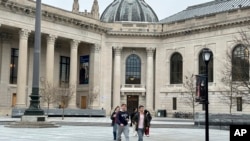
It’s tough to gain admission to Yale University, and it’s getting even tougher for international students as standout students from around the world set their sights on Yale.
The Yale Dale News, the campus newspaper, takes a look at the situation here.
- By VOA News
Student from Ethiopia says Whitman College culture made it easy to settle in

Ruth Chane, a computer science major from Ethiopia, writes about her experiences settling into student life at Whitman College in the U.S. state of Washington.
"The community at Whitman College made sure I felt welcomed even before I stepped foot on campus," she says.
- By VOA News
Claremont Colleges student gets a shock when she heads home to Shanghai
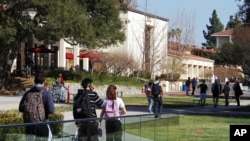
In The Student Life, the student newspaper for the Claremont Colleges, a consortium of five liberal art colleges and two graduate schools in Claremont, California, student Rochelle Lu writes about readjusting to her Shanghai home after spending a semester in the United States.
- By VOA News
Cedarville University aims to ease transition for international students
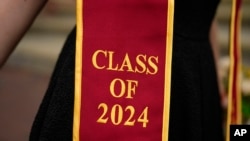
Cedarville University in the U.S. state of Ohio says it’s got more than 140 international students representing 44 countries.
Here, the school interviews Jonathan Sutton, director of international student services. He talks about his job and the opportunities for international students on campus.
- By VOA News
Morehouse College offers prospective students tips on applying and thriving
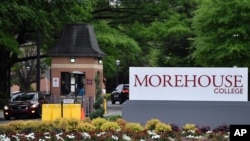
Morehouse College, a private, historically Black liberal arts college in the U.S. state of Georgia, offers a guide for international students interested in attending the school.
Among the tips to apply and thrive at Morehouse:
- Take advantage of the school’s orientation program
- Turn to the school’s Center for Academic Success for tutoring, support and more
- Immerse yourself in campus life via clubs and societies
- By Reuters
US reviews Columbia University contracts, grants over antisemitism allegations

The administration of President Donald Trump said on Monday it will review Columbia University's federal contracts and grants over allegations of antisemitism, which it says the educational institution has shown inaction in tackling.
Rights advocates note rising antisemitism, Islamophobia and anti-Arab bias since U.S. ally Israel's devastating military assault on Gaza began after Palestinian Hamas militants' deadly October 2023 attack.
The Justice Department said a month ago it formed a task force to fight antisemitism. The U.S. Departments of Health and Education and the General Services Administration jointly made the review announcement on Monday.
"The Federal Government's Task Force to Combat Anti-Semitism is considering Stop Work Orders for $51.4 million in contracts between Columbia University and the Federal Government," the joint statement said.
The agencies said no contracting actions had been taken yet.
"The task force will also conduct a comprehensive review of the more than $5 billion in federal grant commitments to Columbia University."
The agencies did not respond to requests for comment on whether there were similar reviews over allegations of Islamophobia and anti-Arab bias.
Columbia had no immediate comment. It previously said it made efforts to tackle antisemitism.
College protests
Trump has signed an executive order to combat antisemitism and pledged to deport non-citizen college students and others who took part in pro-Palestinian protests.
Columbia was at the center of college protests in which demonstrators demanded an end to U.S. support for Israel due to the humanitarian crisis caused by Israel's assault on Gaza. There were allegations of antisemitism and Islamophobia in protests and counter-protests.
During last summer's demonstrations around the country, classes were canceled, some university administrators resigned and student protesters were suspended and arrested.
While the intensity of protests has decreased in recent months, there were some demonstrations last week in New York after the expulsion of two students at Columbia University-affiliated Barnard College and after New York Governor Kathy Hochul ordered the removal of a Palestinian studies job listing at Hunter College.
A third student at Barnard College has since been expelled, this one related to the occupation of the Hamilton Hall building at Columbia last year.
Canada’s immigration overhaul signals global shift in student migration
From Europe to North America, nations are tightening their immigration policies. Now Canada, long seen as one of the world's most welcoming nations, has introduced sweeping changes affecting international students. The reforms highlight a growing global trend toward more restrictive immigration policies. Arzouma Kompaore reports from Calgary.
Trump administration opens antisemitism inquiries at 5 colleges, including Columbia and Berkeley
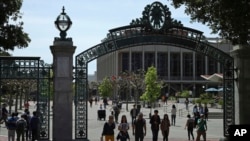
The Trump administration is opening new investigations into allegations of antisemitism at five U.S. universities including Columbia and the University of California, Berkeley, the Education Department announced Monday.
It's part of President Donald Trump's promise to take a tougher stance against campus antisemitism and deal out harsher penalties than the Biden administration, which settled a flurry of cases with universities in its final weeks. It comes the same day the Justice Department announced a new task force to root out antisemitism on college campuses.
In an order signed last week, Trump called for aggressive action to fight anti-Jewish bias on campuses, including the deportation of foreign students who have participated in pro-Palestinian protests.
Along with Columbia and Berkeley, the department is now investigating the University of Minnesota, Northwestern University and Portland State University. The cases were opened using the department's power to launch its own civil rights reviews, unlike the majority of investigations, which stem from complaints.
Messages seeking comment were left with all five universities.
A statement from the Education Department criticized colleges for tolerating antisemitism after Hamas' Oct. 7, 2023, attack on Israel and a wave of pro-Palestinian protests that followed. It also criticized the Biden administration for negotiating "toothless" resolutions that failed to hold schools accountable.
"Today, the Department is putting universities, colleges, and K-12 schools on notice: this administration will not tolerate continued institutional indifference to the wellbeing of Jewish students on American campuses," said Craig Trainor, the agency's acting assistant secretary for civil rights.
The department didn't provide details about the inquiries or how it decided which schools are being targeted. Presidents of Columbia and Northwestern were among those called to testify on Capitol Hill last year as Republicans sought accountability for allegations of antisemitism. The hearings contributed to the resignation of multiple university presidents, including Columbia's Minouche Shafik.
An October report from House Republicans accused Columbia of failing to punish pro-Palestinian students who took over a campus building, and it called Northwestern's negotiations with student protesters a "stunning capitulation."
House Republicans applauded the new investigations. Representative Tim Walberg, chair of the Education and Workforce Committee, said he was "glad that we finally have an administration who is taking action to protect Jewish students."
Trump's order also calls for a full review of antisemitism complaints filed with the Education Department since Oct. 7, 2023, including pending and resolved cases from the Biden administration. It encourages the Justice Department to take action to enforce civil rights laws.
Last week's order drew backlash from civil rights groups who said it violated First Amendment rights that protect political speech.
The new task force announced Monday includes the Justice and Education departments along with Health and Human Services.
"The Department takes seriously our responsibility to eradicate this hatred wherever it is found," said Leo Terrell, assistant attorney general for civil rights. "The Task Force to Combat Anti-Semitism is the first step in giving life to President Trump's renewed commitment to ending anti-Semitism in our schools."
- By VOA News
STEM, business top subjects for international students
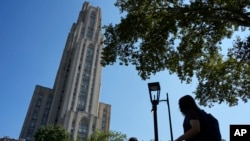
The Times of India breaks down the most popular subjects for international students to study in the U.S.
STEM and business lead the pack. Read the full story here. (January 2025)
- By VOA News
Safety and visa difficulties among misconceptions about US colleges

U.S. News & World report addresses some of the misconceptions about U.S. colleges and universities, including the difficulty of getting a visa.
Read the full story here. (January 2025)
- By VOA News
Work opportunities help draw international students to US schools
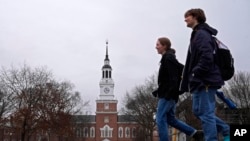
US News & World Report details the three top factors in foreign students' decision to study in the U.S. They include research opportunities and the reputation of U.S. degrees. Read the full story here. (December 2024)
- By VOA News
British student talks about her culture shock in Ohio

A British student who did a year abroad at Bowling Green State University in Ohio talks about adjusting to life in America in a TikTok video, Newsweek magazine reports.
Among the biggest surprises? Portion sizes, jaywalking laws and dorm room beds.
Read the full story here. (December 2024)
- By VOA News
Harvard's Chan School tells international students what to expect

Harvard's T.H. Chan School of Public Health reaches out to international students by detailing the international student experience at the school.
Learn more about housing, life in Boston and more here.
- By Reuters
China unveils plan to build 'strong education nation' by 2035
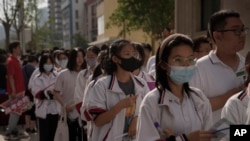
China issued its first national action plan to build a "strong education nation" by 2035, which it said would help coordinate its education development, improve efficiencies in innovation and build a "strong country."
The plan, issued Sunday by the Communist Party's central committee and the State Council, aims to establish a "high quality education system" with accessibility and quality "among the best in the world."
The announcement was made after data on Friday showed China's population fell for a third consecutive year in 2024, with the number of deaths outpacing a slight increase in births, and experts cautioning that the downturn will worsen in the coming years.
High childcare and education costs have been a key factor for many young Chinese opting out of having children, at a time when many face uncertainty over their job prospects amid sluggish economic growth.
"By 2035, an education power will be built," the official Xinhua news agency said, adding that China would explore gradually expanding the scope of free education, increase "high-quality" undergraduate enrolment, expand postgraduate education, and raise the proportion of doctoral students.
The plan aims to promote "healthy growth and all-round development of students," making sure primary and secondary school students have at least two hours of physical activity daily, to effectively control the myopia, or nearsightedness, and obesity rates.
"Popularizing" mental health education and establishing a national student mental health monitoring and early warning system would also be implemented, it said.
It also aims to narrow the gap between urban and rural areas to improve the operating conditions of small-scale rural schools and improve the care system for children with disabilities and those belonging to agricultural migrant populations.
The plan also aims to steadily increase the supply of kindergarten places and the accessibility of preschool education.
- By VOA News
A look at financial aid options for international graduate students in US

The Open Notebook, a site focusing on educating journalists who cover science, has complied a list of U.S. graduate program financial aid information for international students.




